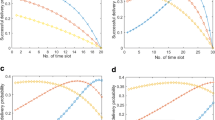Abstract
LWT-MAC is a new Low Power Listening MAC protocol for WSNs designed to rapidly react to instantaneous increases of the network load. It takes advantage of overhearing by waking up all nodes at the end of a transmission to send or receive packets without needing to transmit the long preamble before. In this work, detailed analytical models of the LWT-MAC and B-MAC protocols, for both saturated and unsaturated conditions, are presented. Moreover, the key LWT-MAC parameters are optimized in order to minimize the energy consumption, constrained to obtain the same throughput as the IEEE 802.11 (CSMA/CA) MAC protocol. From the behavior of the optimal LWT-MAC parameters, a heuristic configuration is proposed. Finally, the LWT-MAC is compared to B-MAC, in both single and multi-hop scenarios, showing improvements in energy consumption, throughput and delay.












Similar content being viewed by others
Notes
The effect of the CA timer previously described has not been studied, it is considered that collisions move the system to the unscheduled mode.
References
802.11, IS (1999) Wireless LAN medium access control (MAC) and physical layer (PHY) specifications. ANSI/IEEE Std 802.11. Revised 2007
Polastre J, Hill J, Culler D (2004) Versatile low power media access for wireless sensor networks. In: Proceedings of the 2nd international conference on embedded networked sensor systems (SenSys ’04)
Cano C, Bellalta B, Sfairopoulou A, Barceló J (2009) A low power listening MAC with scheduled wake up after transmissions for WSNs. IEEE Commun Lett 13(4):221–223
Ye W, Heidemann J, Estrin D (2004) Medium access control with coordinated adaptive sleeping for wireless sensor networks. IEEE/ACM Trans Netw 12(3):493–506
Haapola J (2005) Multihop medium access control for WSNs: an energy analysis model. EURASIP J Wirel Comm 2005(4):523–540
Zhang Y, He C, Jiang L (2008) Performance analysis of S-MAC protocol under unsaturated conditions. IEEE Commun Lett 12(3):210–212
Buettner M, Yee G, Anderson E, Han R (2006) X-MAC: a short preamble MAC protocol for duty-cycled wireless sensor networks. In: Proceedings of the 4th international conference on embedded networked sensor systems (Sensys ’06), pp 307–320
Ye W, Silva F, Heidemann J (2006) Ultra-low duty cycle MAC with scheduled channel polling. In: Proceedings of the 4th international conference on embedded networked sensor systems, p 334
El-Hoiydi A, Decotignie J, Hernandez J (2004) Low power MAC protocols for infrastructure wireless sensor networks. In: Proceedings of the fifth European wireless conference, pp 563–569
van Dam T, Langendoen K (2003) An adaptive energy-efficient MAC protocol for wireless sensor networks. In: Proceedings of the first international conference on embedded networked sensor systems (SenSys ’03), p 171. http://portal.acm.org/citation.cfm?doid=958491.958512
Chen D, Varshney P (2004) QoS support in wireless sensor networks: a survey. In: Proceedings of the international conference on wireless networks (ICWN’04), pp 227–233
Paek K, Kim J, Song U, Hwang C (2007) Priority-based medium access control protocol for providing QoS in wireless sensor networks. IEICE Trans Inf Sys 90(9):1448
Liu Y, Elhanany I, Qi H (2005) An energy-efficient QoS-aware media access control protocol for wireless sensor networks. In: Proceedings of the international conference on mobile adhoc and sensor systems conference, pp 189–191
Liu Z, Elhanany I (2006) RL-MAC: a QoS-aware reinforcement learning based MAC protocol for wireless sensor networks. In: Proceedings of the IEEE international conference on networking, sensing and control (ICNSC’06), pp 768–773
Caccamo M, Zhang L, Sha L, Buttazzo G (2002) An implicit prioritized access protocol for wireless sensor networks. In: Proceedings of the 23rd IEEE real-time systems symposium (RTSS’02)
Watteyne T, Augé-Blum I, Ubéda S (2006) Dual-mode real-time MAC protocol for wireless sensor networks: a validation/simulation approach. In: Proceedings of the 1st international conference on integrated internet ad hoc and sensor networks
Lu G, Krishnamachari B, Raghavendra C (2004) An adaptive energy-efficient and low-latency MAC for data gathering in wireless sensor networks. In: Proceedings of the parallel and distributed processing symposium
Cano C, Bellalta B, Barceló J, Sfairopoulou A (2009) A novel MAC protocol for event-based wireless sensor networks: improving the collective QoS. In: Proceedings of the 7th international conference on wired / wireless internet communications (WWIC)
Alizadeh-Shabdiz F, Subramaniam S (2006) Analytical models for single-hop and multi-hop ad hoc networks. Mob Netw Appl 11(1):75–90
Bellalta B, Oliver M, Meo M, Guerrero M (2005) A simple model of the IEEE 802.11 MAC protocol with heterogeneous traffic flows. In: Proceedings of the IEEE Eurocon
Chen G, Branch J, Pflug M, Zhu L, Szymanski B (2004) SENSE: a sensor network simulator. In: Advances in pervasive computing and networking, pp 249–69
Lin X, Zhou J, Mu C (2006) Collective real-time QoS in wireless sensor networks. In: Proceedings of the international conference on wireless communications, networking and mobile computing (WiCOM’06), pp 1–4
Acknowledgements
This work has been partially supported by the Spanish Government under the projects TEC2008-0655/TEC (GEPETO, Plan Nacional I+D) and CSD2008-00010 (COMONSENS, Consolider-Ingenio Program) and by the Catalan Government (SGR2009#00617)
Author information
Authors and Affiliations
Corresponding author
Rights and permissions
About this article
Cite this article
Cano, C., Bellalta, B., Sfairopoulou, A. et al. Taking Advantage of Overhearing in Low Power Listening WSNs: A Performance Analysis of the LWT-MAC Protocol. Mobile Netw Appl 16, 613–628 (2011). https://doi.org/10.1007/s11036-010-0280-4
Published:
Issue Date:
DOI: https://doi.org/10.1007/s11036-010-0280-4




